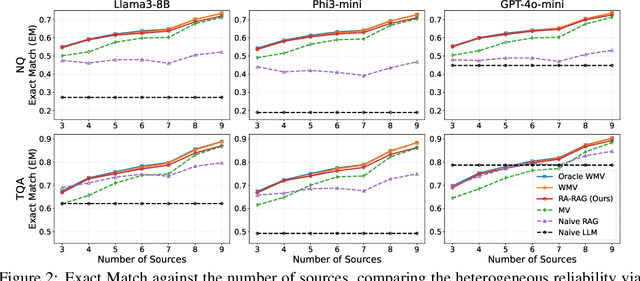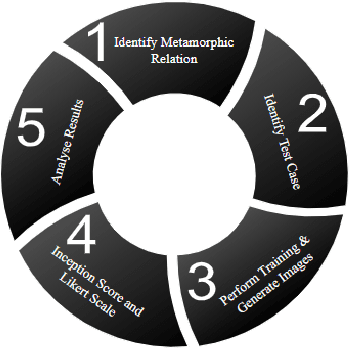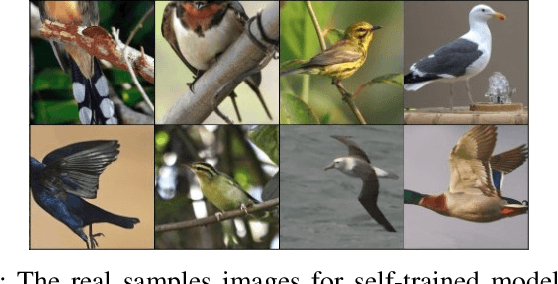Hyejin Park
Semantic Exploration with Adaptive Gating for Efficient Problem Solving with Language Models
Jan 10, 2025Abstract:Recent advancements in large language models (LLMs) have shown remarkable potential in various complex tasks requiring multi-step reasoning methods like tree search to explore diverse reasoning paths. However, existing methods often suffer from computational inefficiency and redundancy. First, they overlook the diversity of task difficulties, leading to unnecessarily extensive searches even for easy tasks. Second, they neglect the semantics of reasoning paths, resulting in redundant exploration of semantically identical paths. To address these limitations, we propose Semantic Exploration with Adaptive Gating (SEAG), a computationally efficient method. SEAG employs an adaptive gating mechanism that dynamically decides whether to conduct a tree search, based on the confidence level of answers from a preceding simple reasoning method. Furthermore, its tree-based exploration consolidates semantically identical reasoning steps, reducing redundant explorations while maintaining or even improving accuracy. Our extensive experiments demonstrate that SEAG significantly improves accuracy by 4.3% on average while requiring only 31% of computational costs compared to existing tree search-based methods on complex reasoning benchmarks including GSM8K and ARC with diverse language models such as Llama2, Llama3, and Mistral.
Retrieval-Augmented Generation with Estimation of Source Reliability
Oct 30, 2024



Abstract:Retrieval-augmented generation (RAG) addresses key limitations of large language models (LLMs), such as hallucinations and outdated knowledge, by incorporating external databases. These databases typically consult multiple sources to encompass up-to-date and various information. However, standard RAG methods often overlook the heterogeneous source reliability in the multi-source database and retrieve documents solely based on relevance, making them prone to propagating misinformation. To address this, we propose Reliability-Aware RAG (RA-RAG) which estimates the reliability of multiple sources and incorporates this information into both retrieval and aggregation processes. Specifically, it iteratively estimates source reliability and true answers for a set of queries with no labelling. Then, it selectively retrieves relevant documents from a few of reliable sources and aggregates them using weighted majority voting, where the selective retrieval ensures scalability while not compromising the performance. We also introduce a benchmark designed to reflect real-world scenarios with heterogeneous source reliability and demonstrate the effectiveness of RA-RAG compared to a set of baselines.
Hybrid-TTA: Continual Test-time Adaptation via Dynamic Domain Shift Detection
Sep 13, 2024Abstract:Continual Test Time Adaptation (CTTA) has emerged as a critical approach for bridging the domain gap between the controlled training environments and the real-world scenarios, enhancing model adaptability and robustness. Existing CTTA methods, typically categorized into Full-Tuning (FT) and Efficient-Tuning (ET), struggle with effectively addressing domain shifts. To overcome these challenges, we propose Hybrid-TTA, a holistic approach that dynamically selects instance-wise tuning method for optimal adaptation. Our approach introduces the Dynamic Domain Shift Detection (DDSD) strategy, which identifies domain shifts by leveraging temporal correlations in input sequences and dynamically switches between FT and ET to adapt to varying domain shifts effectively. Additionally, the Masked Image Modeling based Adaptation (MIMA) framework is integrated to ensure domain-agnostic robustness with minimal computational overhead. Our Hybrid-TTA achieves a notable 1.6%p improvement in mIoU on the Cityscapes-to-ACDC benchmark dataset, surpassing previous state-of-the-art methods and offering a robust solution for real-world continual adaptation challenges.
Dynamic Guidance Adversarial Distillation with Enhanced Teacher Knowledge
Sep 03, 2024Abstract:In the realm of Adversarial Distillation (AD), strategic and precise knowledge transfer from an adversarially robust teacher model to a less robust student model is paramount. Our Dynamic Guidance Adversarial Distillation (DGAD) framework directly tackles the challenge of differential sample importance, with a keen focus on rectifying the teacher model's misclassifications. DGAD employs Misclassification-Aware Partitioning (MAP) to dynamically tailor the distillation focus, optimizing the learning process by steering towards the most reliable teacher predictions. Additionally, our Error-corrective Label Swapping (ELS) corrects misclassifications of the teacher on both clean and adversarially perturbed inputs, refining the quality of knowledge transfer. Further, Predictive Consistency Regularization (PCR) guarantees consistent performance of the student model across both clean and adversarial inputs, significantly enhancing its overall robustness. By integrating these methodologies, DGAD significantly improves upon the accuracy of clean data and fortifies the model's defenses against sophisticated adversarial threats. Our experimental validation on CIFAR10, CIFAR100, and Tiny ImageNet datasets, employing various model architectures, demonstrates the efficacy of DGAD, establishing it as a promising approach for enhancing both the robustness and accuracy of student models in adversarial settings.
Emerging Property of Masked Token for Effective Pre-training
Apr 12, 2024



Abstract:Driven by the success of Masked Language Modeling (MLM), the realm of self-supervised learning for computer vision has been invigorated by the central role of Masked Image Modeling (MIM) in driving recent breakthroughs. Notwithstanding the achievements of MIM across various downstream tasks, its overall efficiency is occasionally hampered by the lengthy duration of the pre-training phase. This paper presents a perspective that the optimization of masked tokens as a means of addressing the prevailing issue. Initially, we delve into an exploration of the inherent properties that a masked token ought to possess. Within the properties, we principally dedicated to articulating and emphasizing the `data singularity' attribute inherent in masked tokens. Through a comprehensive analysis of the heterogeneity between masked tokens and visible tokens within pre-trained models, we propose a novel approach termed masked token optimization (MTO), specifically designed to improve model efficiency through weight recalibration and the enhancement of the key property of masked tokens. The proposed method serves as an adaptable solution that seamlessly integrates into any MIM approach that leverages masked tokens. As a result, MTO achieves a considerable improvement in pre-training efficiency, resulting in an approximately 50% reduction in pre-training epochs required to attain converged performance of the recent approaches.
Salience-Based Adaptive Masking: Revisiting Token Dynamics for Enhanced Pre-training
Apr 12, 2024Abstract:In this paper, we introduce Saliency-Based Adaptive Masking (SBAM), a novel and cost-effective approach that significantly enhances the pre-training performance of Masked Image Modeling (MIM) approaches by prioritizing token salience. Our method provides robustness against variations in masking ratios, effectively mitigating the performance instability issues common in existing methods. This relaxes the sensitivity of MIM-based pre-training to masking ratios, which in turn allows us to propose an adaptive strategy for `tailored' masking ratios for each data sample, which no existing method can provide. Toward this goal, we propose an Adaptive Masking Ratio (AMR) strategy that dynamically adjusts the proportion of masking for the unique content of each image based on token salience. We show that our method significantly improves over the state-of-the-art in mask-based pre-training on the ImageNet-1K dataset.
MedBN: Robust Test-Time Adaptation against Malicious Test Samples
Mar 28, 2024Abstract:Test-time adaptation (TTA) has emerged as a promising solution to address performance decay due to unforeseen distribution shifts between training and test data. While recent TTA methods excel in adapting to test data variations, such adaptability exposes a model to vulnerability against malicious examples, an aspect that has received limited attention. Previous studies have uncovered security vulnerabilities within TTA even when a small proportion of the test batch is maliciously manipulated. In response to the emerging threat, we propose median batch normalization (MedBN), leveraging the robustness of the median for statistics estimation within the batch normalization layer during test-time inference. Our method is algorithm-agnostic, thus allowing seamless integration with existing TTA frameworks. Our experimental results on benchmark datasets, including CIFAR10-C, CIFAR100-C and ImageNet-C, consistently demonstrate that MedBN outperforms existing approaches in maintaining robust performance across different attack scenarios, encompassing both instant and cumulative attacks. Through extensive experiments, we show that our approach sustains the performance even in the absence of attacks, achieving a practical balance between robustness and performance.
Data Distribution Dynamics in Real-World WiFi-Based Patient Activity Monitoring for Home Healthcare
Feb 03, 2024Abstract:This paper examines the application of WiFi signals for real-world monitoring of daily activities in home healthcare scenarios. While the state-of-the-art of WiFi-based activity recognition is promising in lab environments, challenges arise in real-world settings due to environmental, subject, and system configuration variables, affecting accuracy and adaptability. The research involved deploying systems in various settings and analyzing data shifts. It aims to guide realistic development of robust, context-aware WiFi sensing systems for elderly care. The findings suggest a shift in WiFi-based activity sensing, bridging the gap between academic research and practical applications, enhancing life quality through technology.
Automated Audio Captioning and Language-Based Audio Retrieval
Jul 08, 2022



Abstract:This project involved participation in the DCASE 2022 Competition (Task 6) which had two subtasks: (1) Automated Audio Captioning and (2) Language-Based Audio Retrieval. The first subtask involved the generation of a textual description for audio samples, while the goal of the second was to find audio samples within a fixed dataset that match a given description. For both subtasks, the Clotho dataset was used. The models were evaluated on BLEU1, BLEU2, BLEU3, ROUGEL, METEOR, CIDEr, SPICE, and SPIDEr scores for audio captioning and R1, R5, R10 and mARP10 scores for audio retrieval. We have conducted a handful of experiments that modify the baseline models for these tasks. Our final architecture for Automated Audio Captioning is close to the baseline performance, while our model for Language-Based Audio Retrieval has surpassed its counterpart.
Robustness Evaluation of Stacked Generative Adversarial Networks using Metamorphic Testing
Mar 04, 2021



Abstract:Synthesising photo-realistic images from natural language is one of the challenging problems in computer vision. Over the past decade, a number of approaches have been proposed, of which the improved Stacked Generative Adversarial Network (StackGAN-v2) has proven capable of generating high resolution images that reflect the details specified in the input text descriptions. In this paper, we aim to assess the robustness and fault-tolerance capability of the StackGAN-v2 model by introducing variations in the training data. However, due to the working principle of Generative Adversarial Network (GAN), it is difficult to predict the output of the model when the training data are modified. Hence, in this work, we adopt Metamorphic Testing technique to evaluate the robustness of the model with a variety of unexpected training dataset. As such, we first implement StackGAN-v2 algorithm and test the pre-trained model provided by the original authors to establish a ground truth for our experiments. We then identify a metamorphic relation, from which test cases are generated. Further, metamorphic relations were derived successively based on the observations of prior test results. Finally, we synthesise the results from our experiment of all the metamorphic relations and found that StackGAN-v2 algorithm is susceptible to input images with obtrusive objects, even if it overlaps with the main object minimally, which was not reported by the authors and users of StackGAN-v2 model. The proposed metamorphic relations can be applied to other text-to-image synthesis models to not only verify the robustness but also to help researchers understand and interpret the results made by the machine learning models.
 Add to Chrome
Add to Chrome Add to Firefox
Add to Firefox Add to Edge
Add to Edge